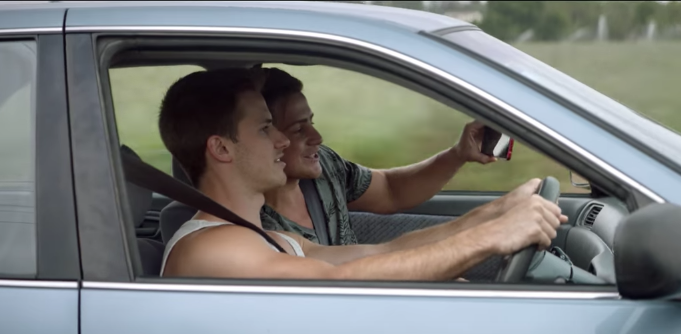
An advertisement from the Australian Pensioners Insurance Agency has been banned by the advertising watchdog after one scene was found to trivialise” the risks of using mobile phones while driving.
The campaign focused on younger people making bad decisions, with scenes showing a number of young people doing things like lifting a heavy object and hurting their back, or working too late.
These choices are accompanied by a band of older APIA customers, singing, “I wish I knew then what I know now”.
Read more: Anytime Fitness falls foul of advertising watchdog over “F*CK UNFIT” campaign
One of the scenes in the ad shows two men aged around 20 attempting to take a photo of themselves whilst driving their car, and as a result swerving into the road’s shoulder.
This scene prompted a significant number of complaints from angry viewers, one labelling the ad a “highly dangerous example to portray to young drivers”.
“This behaviour cannot be advertised as acceptable or normal, many cyclists and pedestrians have been killed or maimed this way,” wrote one complainant.
“Drivers are being fined for holding a phone whilst the engine is running, it is about distraction, these actions cannot be advertised as acceptable.”
Speaking to SmartCompany, director of InsideOut Public Relations Nicole Reaney says despite the ad’s attempt to relate to its audience, it should have steered clear from displaying potentially illegal activity.
“The advertisers have tried to relate to its target audience, however at no point should a commercial business utilise illegal activity in its marketing campaign or angle,” Reaney says.
“In this case, it’s better for a brand to own up to its negligence given it is presenting illegal activity as well as having offended members of the community by its broadcast.”
Scenes in advertisement “misadventures”
However, in a response to the complaints, APIA parent company Suncorp Group defended the advertisement, saying the scenes were intended as an example of “misadventures of the under 50’s”.
“The commercial does not seek to promote these unsafe misadventures, the scenes are designed only to highlight that due to life experience, Apia’s audience know and have learnt from these mistakes,” Suncorp Group said in a response.
“The commercial does not seek to promote unsafe behaviour, but quite the opposite with our ‘knowing’ over 50’s empathetically observing and know if they had their time again they would be making better choices whether its understanding what’s important in life (family) or making mistakes.”
However, the advertising standards board (ASB) dismissed Suncorp Group’s defence and ruled the advertisement contravened section 2.6 of the AANA Code of Ethics, relating to unsafe behaviour.
The ASB considered the scene of the two young men driving in comparison to other scenes shown in the ad and determined the car scene “is the only one with life-threatening consequences”.
“In the view of the majority of the Board, the issue of driver distraction specifically related to mobile phone use is a very serious matter and the depiction of this in the current advertisement trivialises the impact that this could have on people’s lives,” the ASB determined.
“The Board noted that the issue of driver distraction and the use of mobile phones while driving is a very serious matter and that it is illegal for a driver to use a phone while driving
unless it is in an appropriate hands free device.”
“The Board considered that the fact that the driver was seen to ‘get away with it’ means that he is unlikely to have learned a lesson about this action being the wrong thing to do.”
Lauren Rosewarne, advertising expert and academic at The University of Melbourne, says advertisers can only show reckless driving in educational advertisements such as ones by the Transport Accident Commission.
“Sometimes speeding, without phone use, is shown when the speedometer is concealed and when there are not other cars on the road,” Rosewarne told SmartCompany.
“This is a way marketers can get around the no-unsafe-driving code.”
An advertisement from Bentleys last year attempted to skirt around the code but was banned by the watchdog for showing the speedometer in the advertisement.
To prevent issues with the advertising standards board, Reaney advises businesses to commit to vetting advertisements through “multiple layers” to make sure they are not likely to generate complaints.
“This example shows the importance of having multiple layers of approval processes from various perspectives, including legal, whenever messages are being presented to the public, as a means to prevent or at least prepare a brand for reactions,” she says.
Suncorp Group said in a response it agreed with the ASB’s decision and will modify the advertisement to no longer show the scene in the car, instead replacing it with a scene with “no reference” to a mobile phone.
SmartCompany contacted Suncorp Group but did not receive a response prior to publication.
Never miss a story: sign up to SmartCompany’s free daily newsletter and find our best stories on Twitter, Facebook, LinkedIn and Instagram.


COMMENTS
SmartCompany is committed to hosting lively discussions. Help us keep the conversation useful, interesting and welcoming. We aim to publish comments quickly in the interest of promoting robust conversation, but we’re a small team and we deploy filters to protect against legal risk. Occasionally your comment may be held up while it is being reviewed, but we’re working as fast as we can to keep the conversation rolling.
The SmartCompany comment section is members-only content. Please subscribe to leave a comment.
The SmartCompany comment section is members-only content. Please login to leave a comment.